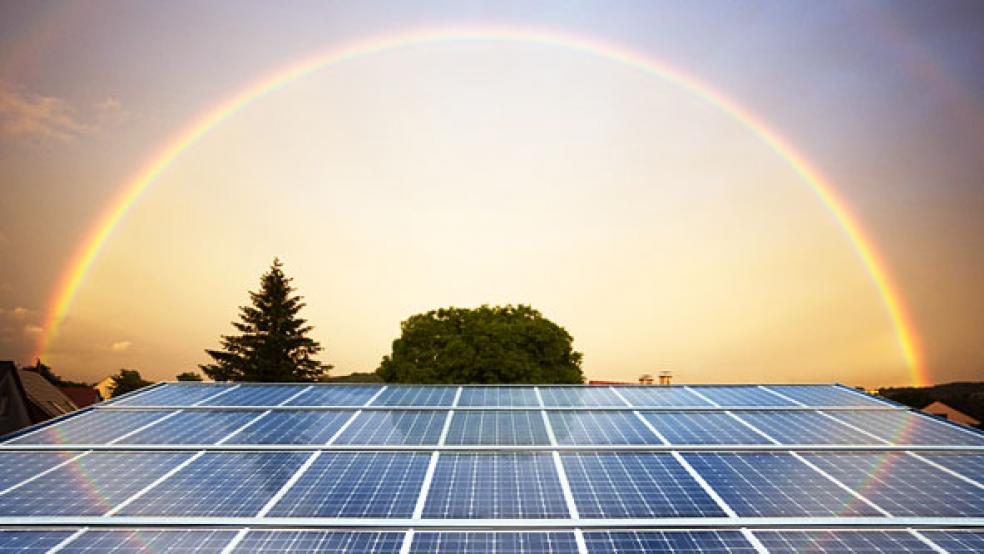Minnesota is not known for its endless days of sunshine. But it soon may be known as a hotspot for energy emanating from the sun. This is thanks to Minneapolis-based TenKsolar, a start-up that has created newfangled solar panels that boost energy output by as much as 50 percent over conventional solar cells, for a cost that is lower per kilowatt hour than electricity in some major cities.

The technology, however, is not flashy or dramatic. It’s so obvious and, well, boring that the Wall Street Journal recently called it a “mundane innovation.”
Essentially, the company has rearranged the wiring and added some reflectors to conventional solar arrays, those rows of black and silver panels tilted toward the sun that run in waves across rooftops of some towns and cities, and on smaller panels attached to streetlamps, traffic signals, and billboards.
“We have repackaged how solar cells are wired to make individual panels in a fundamentally more efficient way,” says CEO Joel Cannon. “We also added reflectors that have a unique ability to reflect light better than conventional solar panels.”
The most significant innovation in TenKsolar’s panels addresses a problem with conventional solar panels that limits the energy output in a string of cells to the lowest performing cell. Called “the Christmas light effect”, this causes entire arrays to drop power output when a shadow falls on a single cell, or a total black out if one cell fails. Led by co-founder Dallas Meyer, a former computer engineer, TenKsolar fixed this problem by mimicking solutions developed by the computer industry to boost memory and speed in disc drives and microprocessors. "We've architected a system that's completely redundant from the cell down to the inverter," Meyer told Technology Review. "If anything fails in the system, it basically has very low impact on the power production of the array."
The rewiring also allows a more efficient use of reflectors, which on traditional panels deliver sunlight unevenly, causing drops in power when reflected light dips in intensity. TenKsolar also uses films on their reflectors developed by 3M to reduce glare and to keep the sun power steady.
“It's a somewhat clever idea, built around something a lot of companies are trying -- separate power conditioning equipment that goes with each module,” says Ken Zweibel, Director of the GW Solar Institute at George Washington University. “Improving the electronics while you add mirrors is a different idea - maybe it works well enough to pay for the extra electronics, wires, and mirrors - maybe not.” Zweibel noted that he was unfamiliar with the details of TenKsolar’s technology, but was commenting on the general idea.
The company’s solar cells potentially save money by requiring only about three-quarters the square-footage of regular panels to produce the same amount of energy, and by being up to 20 percent more efficient over the lifetime of the cells.
These savings reduce the price paid by TenKsolar customers to as low as eight cents per kilowatt-hour on a sunny day, says CEO Cannon, a 20 percent reduction in the 10 cent price per kilowatt-hour retail now paid be U.S. consumers for electricity, although the solar rate can vary widely according to variations in sunlight and latitude (northern and southern climes get less consistent sun per day throughout the year). Actual costs of power vary widely, though, depending on incentives and subsidies at the state and local level from governments and power companies. For instance, California and New Jersey have aggressive programs to incentivize power companies and consumers to go solar.
Cannon says his company has raised $11 million in financing since its founding in 2008. The company expects to earn $18 million in revenues in 2011, with sales over $100 million next year. This compares to a total solar market in the U.S. of $6 billion in 2010, nearly double that of 2009, according to the Solar Energy Industry Association. New solar installations also doubled from 2009 to 2010, and are expected to more than double this year. To keep up with demand, solar jobs are rising fast in the U.S., reaching 93,000 last year.
Solar, however, is not yet competitive as a raw source of power. Even TenKsolar’s more efficient panels generate electricity at a rate that’s four times as expensive as coal, and twice the cost of natural gas – a number that Cannon expects to go down at a faster rate than their competitors in an industry that is already seeing its pricing go down as it scales up.
Last year solar power produced 1.3 million megawatts per hour of energy, up over 30 percent from 2009. This is still a tiny fraction of the 168 million megawatt hours produced by all renewable energy sources (wind, geothermal, and biomass). The U.S. currently ranks sixth in solar energy capacity; Germany and Italy are the leaders.
Still, Joel Cannon makes a bold prediction: that his little company from Minnesota with the boring technology might one day dominate the industry as it works to rewire the sun.
Ratings for TenKsolar’s technology
These ratings are based on the current state of the innovation, with five stars awarded for ideas that are ready both technically and commercially to make a significant economic impact, and are adequately funded. Five stars will be hard to get, but that doesn’t mean that the investment isn’t justified. Awarding four stars means the innovation is close to ready; and so forth.
Overall Rating: ★ ★ ★1/2
Viability of the idea, science or technology: ★ ★ ★
TenKsolar’s technology is based on conventional solar panels combined with engineering schemas from the disc drive industry, which has been radically improving storage capacity and efficiency for years. This combined with a clever use of reflectors makes this technology poised to make solar significantly more cost effective, even if it remains a long way from beating out coal or natural gas as a raw power source. State and federal subsidies and power company offsets for the use of solar power will continue to help mitigate the costs of solar.
Commercial Viability: ★ ★ ★
TenKsolar is already manufacturing and selling its new panels, with sales next year expected to reach $100 million, according to the company. This is a small fraction of the $6 billion solar market in the U.S., and an even smaller fraction of the total renewable energy market. Solar as an industry has been expensive and therefore not as competitive as wind and biomass – never mind fossil fuels – although efficiencies and scaling are beginning to drive solar costs down, particularly where government incentives are in place and where the sun shines prodigiously. TenKsolar’s innovations seem to place it on the leading edge of trends towards more efficient technology and scaling in an industry that is tiny, but rapidly growing.
Investment Funding: N/A
The company has raised $11 million so far, and is already earning revenues. The Fiscal Times has not seen the company’s business plan, so we are unable to assess if TenKsolar will attract adequate investment to support its earnings projections.
Impact and Benefits: ★★★★
Increasing the output and potentially lowering the costs of delivering “clean” solar power is a big win in the quest to reduce America and the world’s dependence on “dirty” power from fossil fuels. Reducing the square footage of solar panels on roofs throughout our land also is a visual plus.






